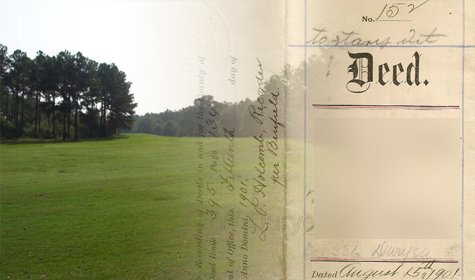When the metes-and-bounds description in a deed conflicts with another, more general description in the deed, which controls? The Texas Supreme Court recently answered this question in Stribling v. Millican DPC Partners, LP. [Read full opinion here.]
Millican and McGregor are neighboring landowners in Brazos County. They are at odds over which of them owns a 34.28 acre tract.
Tracing this back in the deed records, there is a 1945 deed that, using metes-and-bounds identifies 202 acres, including the 34 acre tract in dispute, as being deeded from Roy Nun to PP Prescott.
Things get complicated, however, when a 1973 deed conveyed 4,900 acres from the Prescott family to Barnett. The parties disagree as to whether the 34 acres at issue was included in that transfer. If the land was included, then Millican holds title to the land. If it was not, however, Millican does not have title.
The 1973 deed describes the land being deeded as including “a 202 acre tract out of Thomas Henry Survey, Abs. No. 130, and described in a deed from Rowy W. Nunn, to P.P. Prescott, of record in Vol. 137 Page 285 of the Deed Records of Brazos County.” The parties agree that this general language does describe the 34 acres at issue. Conversely, however, the 1973 deed’s metes-and-bounds description, which is said to “more fully describe” the tracts, does not include the 34 acre tract.
It is the inconsistency in this 1973 deed that led to this lawsuit. The general description purports to convey the 34 acres, while the metes-and-bounds do not.
The trial court found that the metes-and-bounds controlled. The court of appeals reversed, holding that the general description controlled, reasoning that the 1973 deed should be construed to convey the greatest estate the terms permit.
Applicable Law
Courts seek to discern the parties language from the deed’s language in its entirety “without reference to matters of mere form, relative position of descriptions, technicalities, or arbitrary rules.” Further, all parts of a written document must be harmonized and given meaning, if possible. However, in the case of conflict, more specific provisions will control.
Holding
The Supreme Court held that where the descriptions differ and cannot be harmonized with one another, the metes-and-bounds description controls. Because the metes-and-bounds description was more specific, the court reasoned it better indicated the parties’ intent. The Court feared that accepting Millican’s argument that the general description should control “would inject uncertainty into long-settled land records whenever the metes-and-bounds description conflicts with other language in the deed.” Instead, the specific language controls.
Additionally, the court also noted that this ruling does not render general descriptions in a deed meaningless. General descriptions referring to prior deeds can be helpful in tracing title and may be used to help interpret the specific description if it is defective or doubtful.
Why It Matters
This case offers an important lesson for landowners, whether buying or selling property. It is critical that deeds be carefully read and analyzed to ensure that the deed accurately reflects the agreed upon transaction between the parties. Further, it is important that parties ensure there are no inconsistencies in the deed, and in particular ensure that any descriptions of the land be consistent with one another.
Tiffany Dowell grew up on her family farm and ranch in Northeastern New Mexico and is currently an Assistant Professor and Extension Specialist in Ag law with Texas A&M Agrilife Extension. This information is for educational purposes only, does not create an attorney-client relationship, and is not a substitute for the advice of a licensed attorney.

